Now Photo Runby 2 at the Bass Point Creek High Bridge.


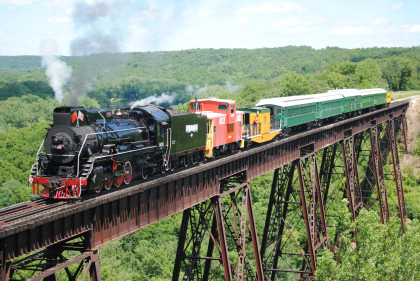
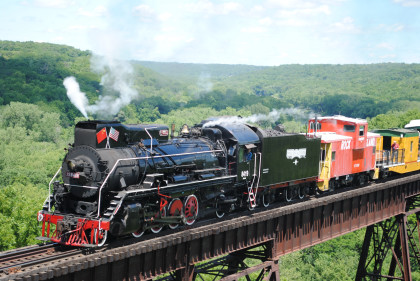
Photo Runby 2. We sent the first group down and the next group joined us up at the lookout point.
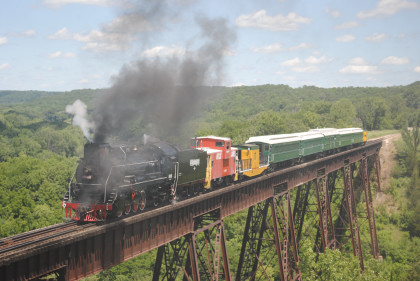
Reverse move 3.

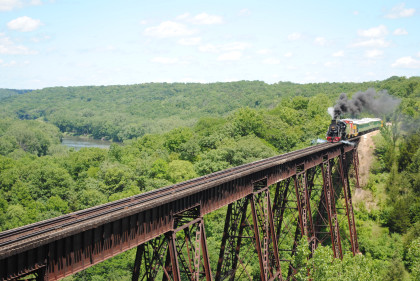
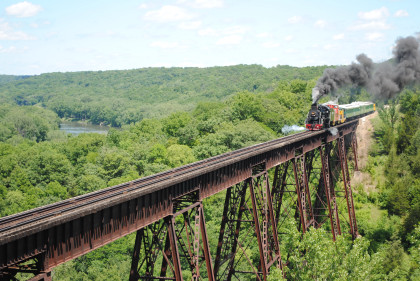

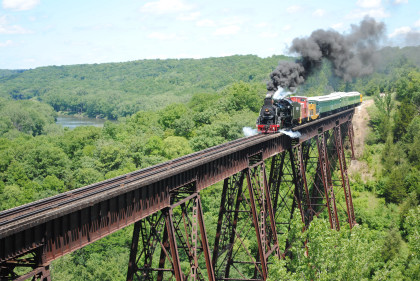

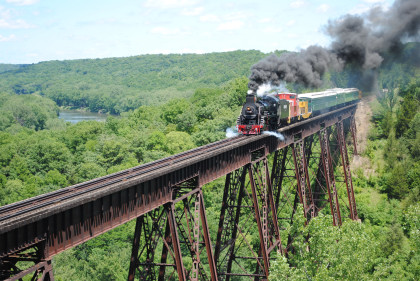

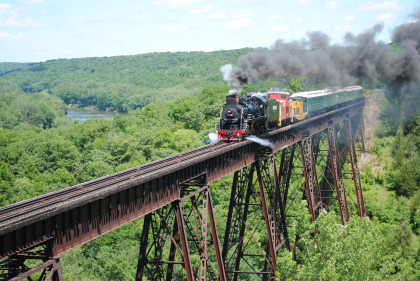
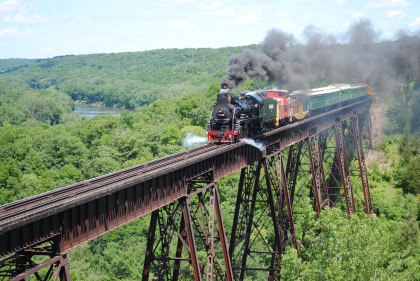
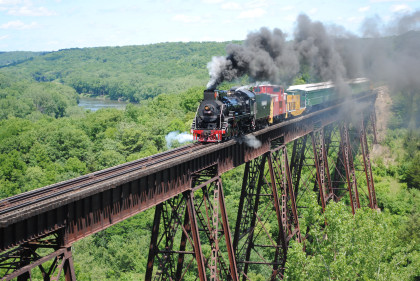
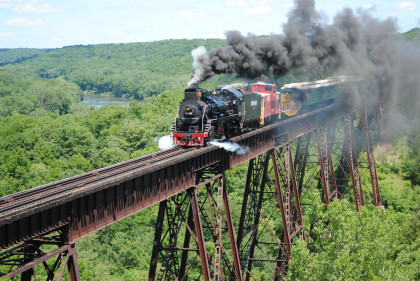
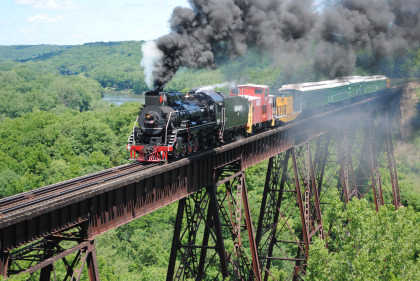
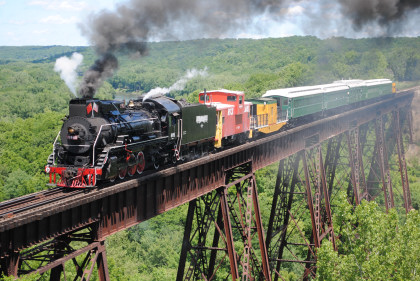

Photo Runby 3, after which the train crew announced that this was the last photo runby and all passengers should return to the train.

Our passengers returning.
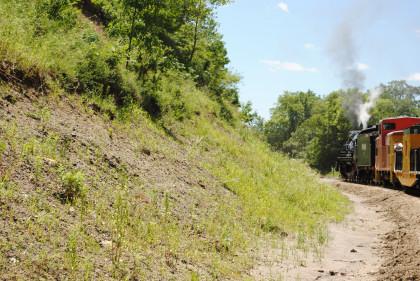
Our train ready to pull us back to Boone.
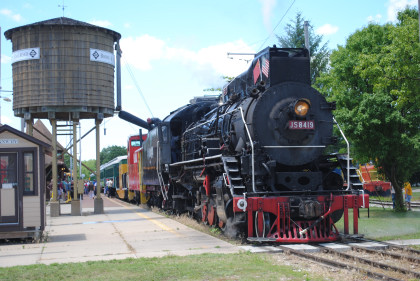
We returned to Boone, ending a great trip on the Boone and Scenic Valley Railroad. A special thank you to the train crew of this fantastic tourist train. Now they would water the steam engine so it could leave at 1:30 PM with a regular train. Lunch would be distributed, but I had other plans.
Our Trolley RideI boarded Charles City Western Car 50 for our trolley trip. This 38-seat semi-steel combine was built by the Mc Guire-Cummings Company of Paris, Illinois in 1915 and replaced a 55-foot McKeen windsplitter when the Charles City & Western was electrified in 1915. Known colloquially as the "lead sled", it was geared down so that it was capable of pulling railroad cars. At the end of 1963, the CCW was sold to the Iowa Terminal Railroad and the car became Iowa Terminal 101. It was stored after dieselization of the CCW, until its movement to the Boone and Scenic Valley for restoration and conversion to 675v DC operation in the 1980's.
It was heated by a coal-fired furnace located in the baggage compartment, with ductwork along one side of the car directing the forced air heat to the smoker and passenger compartment. This type of interurban car was powered by electricity provided by an overhead copper wire supplying the car as it sped through the countryside, free from soot or fumes. The interurban era of the country started in the late 1890's and lasted up into the 1950's, with a few surviving lines still serving the larger metropolitan areas of the country. It was the convenience of the automobile which led to the demise of this form of transportation.
Car Number 50 spent its entire service life on the Charles City Western Railway from 1915 to the end of regular passenger service in 1952. Occasionally it was used in later years for railfan and special trips until 1968 when a tornado damaged overhead electric transmission system, putting the car out of service permanently on the CCW. The car was put in the barn and left there until members of the Iowa Railroad Historical Society found it in 1987, and arranged for its purchase and delivery to Boone that same year.
The car was in excellent condition, probably never having spent a night outside its regular storage barn. The car had been painted inside with a light green latex paint, so popular in the 1950's and 1960's. The restoration of Car 50 involved removal of the old paint and varnish, uncovering the beautiful oak woodwork and paneling that you see today. Three coats of varnish were added. The car has been completely re-wired, and seats were found to replace those sold years ago. The old window glass was replaced with safety glass. The stained glass in the upper sash is the original as found in the car.
The exterior of the car was brush-painted by hand as it would have been in its earlier day. The original brass has been polished, the original light shades have been cleaned and replaced. The car, as it was found in 1987, had almost no rust and very few pieces of wood that were in need of replacement. This is truly one of the rarest finds in a mint condition example of early American electric interurban passenger cars, sometimes referred to as a trolley, although that same term usually applied to the cars that plied the city street railways.
Now sit back and take a trip down this unique operation.
The trolley started moving.
Waves of goodbyes from my friends.
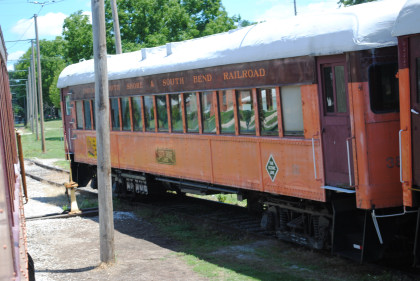
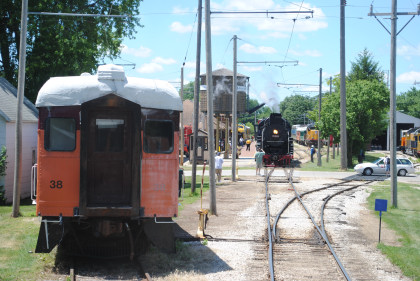
Passing the South Shore cars and out into Boone east we went.

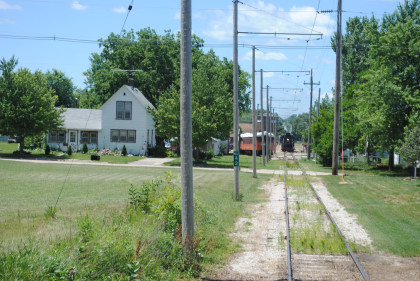
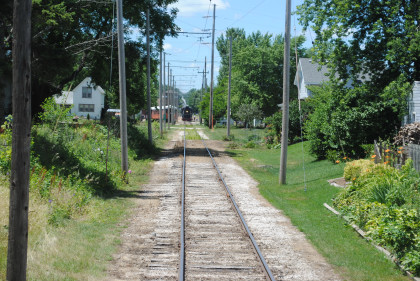

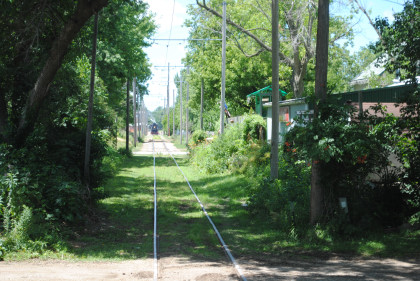
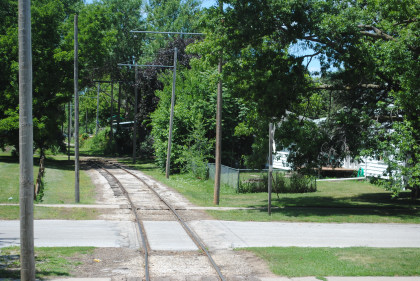

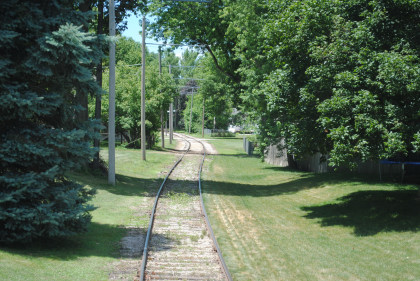
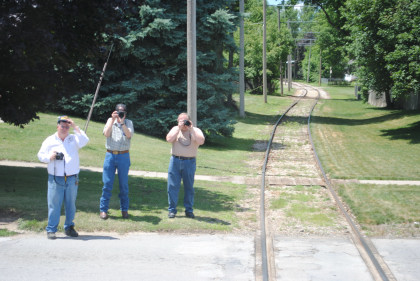





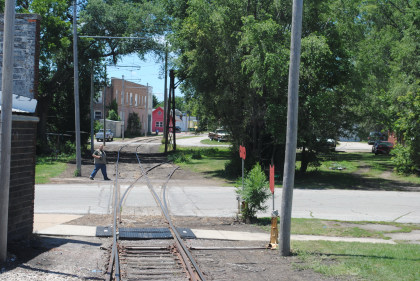
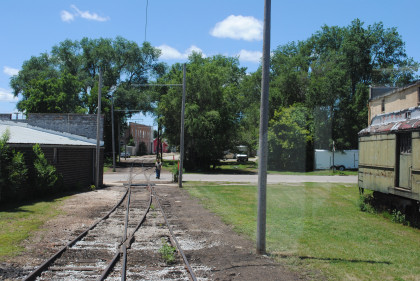
That was a ride east aboard the Charles City and Western Car 50. We were let off the trolley to photograph.

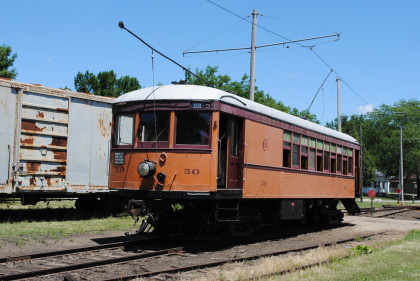

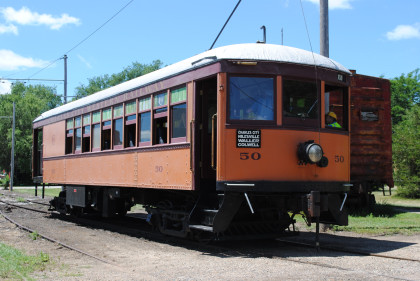
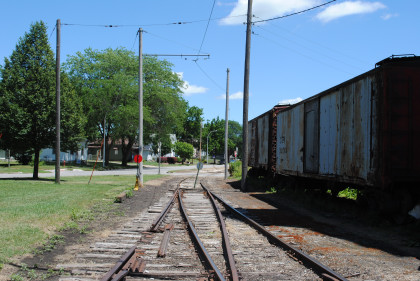
Views of the car, after which I reboarded.
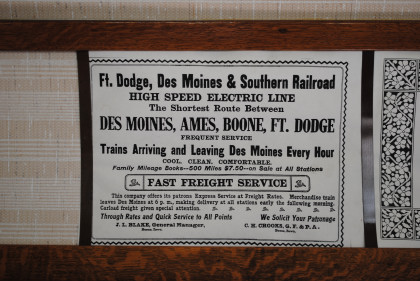
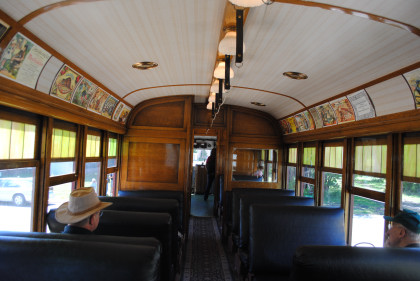

The interior of the interurban car.
Once our passengers had boarded the car, we returned to Boone station.
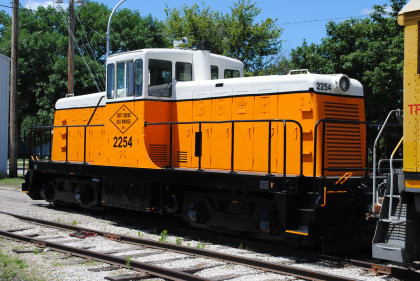
Fort Dodge & Des Moines 80 ton switcher 2254.

Minneapolis & St. Louis Railroad RS-1 244.
Boone and Scenic Valley 45 ton switcher 1858. That brought an end to my photography here at Boone. I helped load Bus 1 and it left with just two empty seats. We then boarded Bus 2, but soon learned that the third trolley trip missed a car that had not stopped at the crossing and in addition, a plank came up from the crossing boards. We moved the bus over to the grade crossing near where the trolley would stop. We waited and after a while, it returned to the stop and we boarded those passengers, then returned to Cedar Rapids.
While I would have liked to participate in all the events at this year's convention, certain non-rail events always occur during the railroad events. Below is the information for the ones that took place during our trip to the Boone & Scenic Valley Railroad Trip today.
Oelwein Hub City Heritage Railway Museum Tour

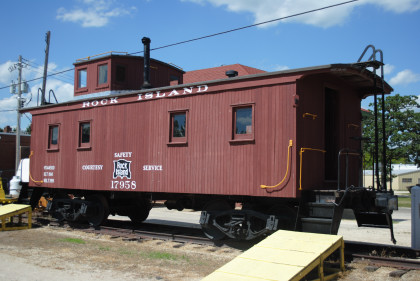
The Chicago Great Western Railway was one of America's leading regional carriers from the turn of the century through the 1960's. Headquartered out of Oelwein from 1952 until its merger with the Chicago and North Western in 1968, the CGW spanned 1,432 miles in Illinois, Iowa, Minnesota, Missouri and into a small extent Nebraska and Kansas.
The Hub City Heritage Railway Museum opened in 1987 and features the railway express building, yard office, yard tower and a collection of locomotives, rolling stock, pump handcar and a gift shop. There is also an extensive collection of employee records, pictures and other memorabilia.

This museum was originally the home of Wells Fargo and Company Express, built in 1912. In 1918, the express company was acquired by the American Railway Express Company as part of a consolidation movement and in the 1930s became the Railway Express Agency (REA). The yard office and yard tower were the heart of the Chicago Great Western in its heyday. The tower, which was built in 1953, provides an outstanding view of the former CGW switching yards. Much of the interior of these building is as they were when vacated in 1969.
Independence Illinois Central Railroad Museum
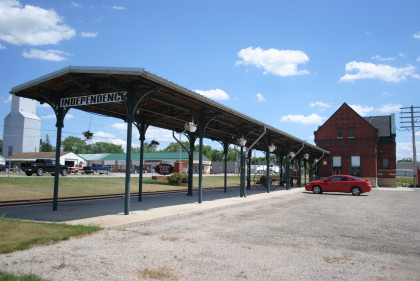
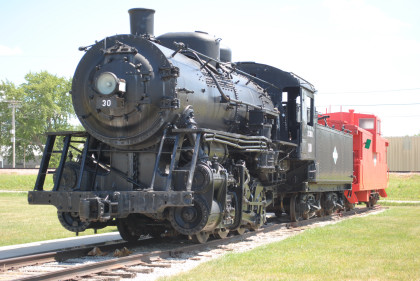
The railroad that is today the Canadian National/Illinois Central arrived in Independence on December 12, 1859. In 1892, the railroad built the current brick passenger depot. Because of the nearby horse race track, a number of notable people arrived in Independence at this station. These include Presidents McKinley and T. Roosevelt, Tom Thumb, Susan B. Anthony, Carrie Nation and John Phillips Sousa and his band.
The depot and baggage building were moved to its current location in 1996 and restored by Buchanan County Tourism. Today it operates as the Buchanan County Tourism Information Center. Outside is former Grand Trunk Western steam locomotive 8300, disguised as an Illinois Central locomotive, formerly at the Northwestern Steel & Wire Mill in Sterling, Illinois. Inside the depot is a nice collection of railroad artifacts from the region.
ADM Smokestack TourIn 1902, George A. Archer and John W. Daniels began a linseed crushing business. In 1923, Archer-Daniels Linseed Company acquired Midland Linseed Products Company and the Archer-Daniels-Midland Company was formed. Today, Archer Daniels Midland (ADM) is the nation's largest private railcar and railroad operator, and Cedar Rapids is one of its most important terminals.
Located near our convention hotel, the ADM Car Shops has an interesting history. It was once the IEI Container Services car shops. Then, in 1996, the Crandic built their new locomotive and car shops here. However, that lasted less than ten years before the facilities were sold to ADM in 2005 to be used to maintain their large car fleet. Today, this facility is responsible for maintaining, cleaning and painting much of ADM's railcar fleet.
Nearby is ADM's new ethanol plant, requiring 250,000 bushels of corn a day, making it the world's largest ethanol complex. To handle the almost continuous rail switching, ADM operates its own intra-plant switching operation.
Kalona Heritage TourKnown as the "Quilt Capital of Iowa", Kalona is home to the largest Amish and Mennonite settlement west of the Mississippi River, something that began when three Old Order Amish families established homesteads near Deer Creek the year Iowa became a state. Today, it is the home of members of the three major Amish sects, as well as both major Mennonite sects. Since first arriving in the area in 1846, the Amish have changed very little in their beliefs and lifestyle. The Old Order Amish have no telephones, electricity, cars or other modern conveniences. Horse-drawn wagons hauling hay, corn, hogs and logs are a common sight. The New Order Amish permit rubber tires on their buggies and farm vehicles, while the "Beachy" use electricity and telephones, drive cars and own modern conveniences including farm equipment.
The presence of the Amish and Mennonite, along with its rural location, gives Kalona a pioneer feel, one that is emphasized by its one-of-a-kind downtown and countryside shops and cottage industries. Thanks to a home grown, cutting-edge medical instruments company, Kalona is even known in the international high-tech marketplace.
However, the Amish and Mennonite are not the real reason for the creation of Kalona. Instead, it is a combination of a cattle baron and the railroad industry. Today's Kalona is located in the low lands of the English River valley. John G. Myers, a rancher who raised shorthorn cattle in the area, suggested to the builders of the Burlington, Cedar Rapids & Northern that they name the station near his property Myersville. However, the railroad turned him down. Being a resourceful man of some wit, Myers then offered the name Kalona, which having the sound of an Indian name, suited the railroad officials. What they did not know and Myers did not explain was that Kalona was the name of his registered prize sire bull.
The Kalona Rock Island station.
Kalona station information.
The Kempftown Store, Richmond Post Office and Straw College.
The Synder Log House.
The Line Shaft Building, Millers Buggy Barn and Grandpa House.
That is what occurred at the 2012 NRHS Cedar Rapids convention on this date.
Nathan and I drove to TJ's Steakhouse at 1810 6th Street Southwest in Cedar Rapids where I enjoyed my best meal yet, having a 12 ounce sirloin steak then worked on the stories back at the Motel 6 and called it a night.
| RETURN TO THE MAIN PAGE |